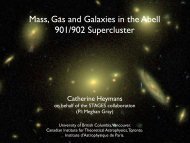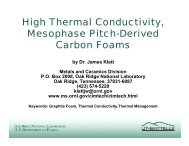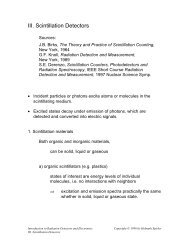Introduction to radiation-resistant semiconductor devices and circuits
Introduction to radiation-resistant semiconductor devices and circuits
Introduction to radiation-resistant semiconductor devices and circuits
Create successful ePaper yourself
Turn your PDF publications into a flip-book with our unique Google optimized e-Paper software.
commonly present in the lattice as an impurity, react in very different ways with<br />
vacancies <strong>to</strong> form complexes with a variety of electronic characteristics (see ref.<br />
(7) <strong>and</strong> references therein). Fortui<strong>to</strong>usly, although a multitude of competing effects<br />
can be invoked in <strong>to</strong> predict <strong>and</strong> interpret experimental results, the data can be<br />
described by rather simple parametrizations.<br />
The increase in reverse bias current (leakage current) is linked <strong>to</strong> the creation<br />
of mid-gap states. Experimental data are consistent with a uniform distribution of<br />
active defects in the detec<strong>to</strong>r volume. The bias current after ir<strong>radiation</strong><br />
Idet = I0 + α ⋅Φ ⋅ Ad<br />
(1)<br />
where I0 is the bias current before ir<strong>radiation</strong>, α is a damage coefficient dependent<br />
on particle type <strong>and</strong> fluence, Φ is the particle fluence, <strong>and</strong> the product of detec<strong>to</strong>r<br />
area <strong>and</strong> thickness Ad is the detec<strong>to</strong>r volume. For 650 MeV pro<strong>to</strong>ns α≈<br />
3⋅10 -17 A/cm (8,9) <strong>and</strong> for 1 MeV neutrons (characteristic of the albedo emanating<br />
from a calorimeter) α≈ 2⋅10 -17 A/cm. (9) The parametrization used in Eq. 1 is quite<br />
general, as it merely assumes a spatially uniform formation of electrically active<br />
defects in the detec<strong>to</strong>r volume, without depending on the details of energy levels<br />
or states.<br />
The coefficients given above apply <strong>to</strong> room temperature operation. The reverse<br />
bias current of silicon detec<strong>to</strong>rs depends strongly on temperature<br />
2 − E / 2k<br />
T<br />
IR ( T ) ∝ T e B<br />
if the generation current dominates (10), as is the case for substantial <strong>radiation</strong><br />
damage. The effective activation energy E= 1.2 eV for <strong>radiation</strong> damaged samples<br />
(8)(11)(12), whereas unirradiated samples usually exhibit E= 1.15 eV. The ratio of<br />
currents at two temperatures T1 <strong>and</strong> T2 is<br />
2<br />
IR<br />
( T2<br />
) ⎛ T ⎞ ⎡ ⎛ − ⎞⎤<br />
= ⎜ 2 E T<br />
⎟ ⎢−<br />
⎜ 1 T<br />
exp<br />
2 ⎟⎥<br />
(3)<br />
IR<br />
( T1)<br />
⎝ T1<br />
⎠ ⎣ 2kB<br />
⎝ T1T2<br />
⎠⎦<br />
After ir<strong>radiation</strong> the leakage current initially decreases with time. Pronounced<br />
short term <strong>and</strong> long term annealing components are observed <strong>and</strong> precise fits <strong>to</strong> the<br />
annealing curve require a sum of exponentials. (9) Experimentally, decreases by<br />
fac<strong>to</strong>rs of 2 <strong>to</strong> 3 have been observed with no further improvement after 5 months<br />
or so. (8,5) In practice, the variation of leakage current with temperature is very<br />
reproducible from device <strong>to</strong> device, even after substantial doping changes due <strong>to</strong><br />
<strong>radiation</strong> damage. The leakage current can be used for dosimetry <strong>and</strong> diodes are<br />
offered commercially specifically for this purpose.<br />
8<br />
(2)





